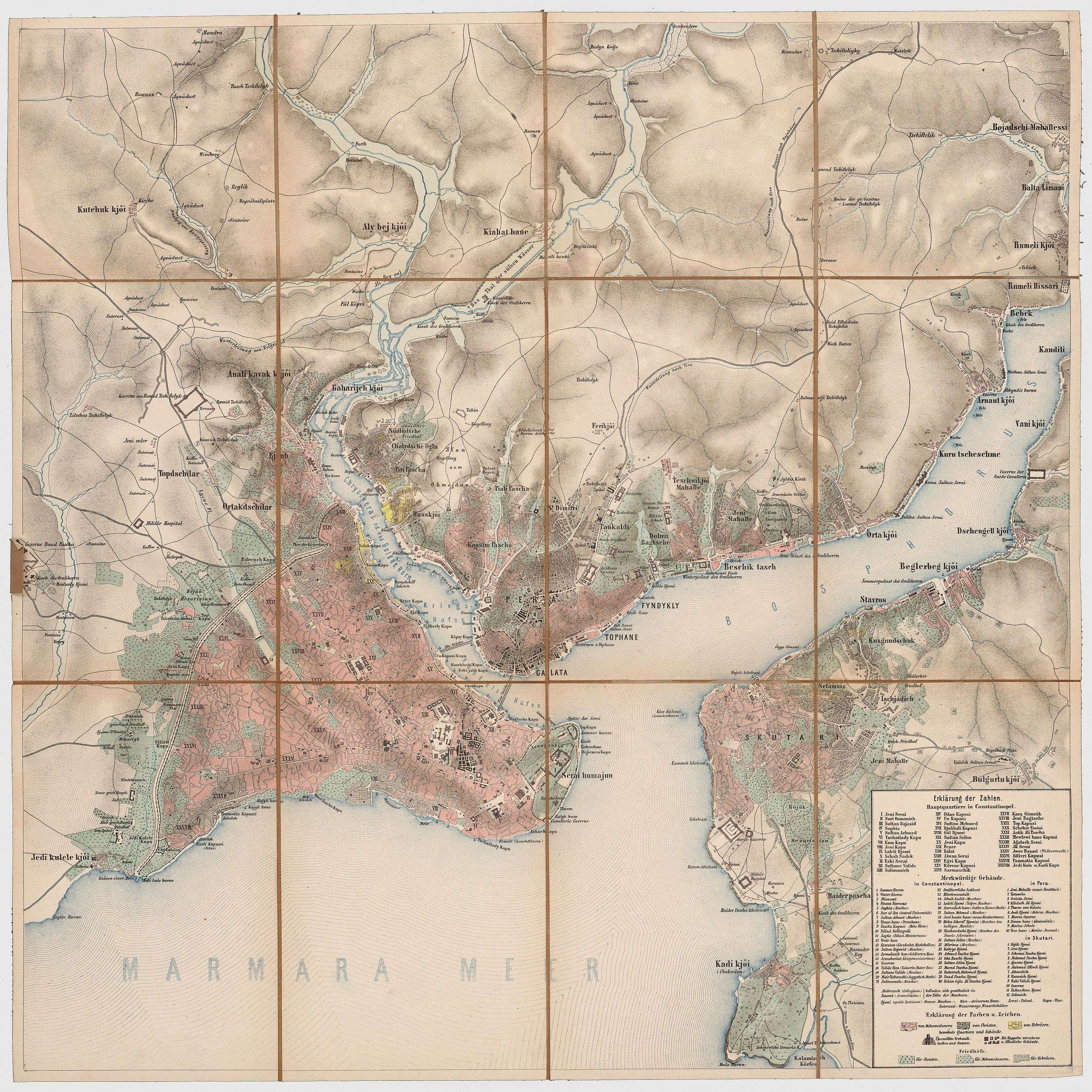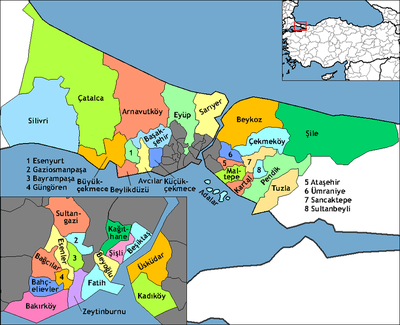Üsküdar
| Üsküdar Üsküdar Belediyesi | |
|---|---|
| Municipality of Üsküdar | |
|
Kız kulesi (Maiden's Tower), off the coast of Üsküdar | |
 | |
 Üsküdar | |
| Coordinates (Municipal Building): 41°1′26.36″N 29°0′59.48″E / 41.0239889°N 29.0165222°E | |
| Country | Turkey |
| Province | Istanbul Province |
| Made a municipality of Istanbul | 1984 |
| Neighborhoods |
List
|
| Government | |
| • Mayor | Hilmi Türkmen (AKP) |
| Area[1] | |
| • District | 46.41 km2 (17.92 sq mi) |
| Population (2012)[2] | |
| • District | 535,916 |
| • District density | 12,000/km2 (30,000/sq mi) |
| Website | http://www.uskudar.bel.tr |
Marmaray route | |||||||||||||||||||||||||||||||||||||||||||||||||||||||||||||||||||||||||||||||||||||||||||||||||||||||||||||||||||||||||||||||||||||||||||||||||||||||||||||||||||||||||||||||||||||||||||||||||||||||||||||||||||||||||||||||||||||||||||||||||||||||||||||||||||||||||||||||||||||||||||||||||||||||||||||||||||||||||||||||||||
|---|---|---|---|---|---|---|---|---|---|---|---|---|---|---|---|---|---|---|---|---|---|---|---|---|---|---|---|---|---|---|---|---|---|---|---|---|---|---|---|---|---|---|---|---|---|---|---|---|---|---|---|---|---|---|---|---|---|---|---|---|---|---|---|---|---|---|---|---|---|---|---|---|---|---|---|---|---|---|---|---|---|---|---|---|---|---|---|---|---|---|---|---|---|---|---|---|---|---|---|---|---|---|---|---|---|---|---|---|---|---|---|---|---|---|---|---|---|---|---|---|---|---|---|---|---|---|---|---|---|---|---|---|---|---|---|---|---|---|---|---|---|---|---|---|---|---|---|---|---|---|---|---|---|---|---|---|---|---|---|---|---|---|---|---|---|---|---|---|---|---|---|---|---|---|---|---|---|---|---|---|---|---|---|---|---|---|---|---|---|---|---|---|---|---|---|---|---|---|---|---|---|---|---|---|---|---|---|---|---|---|---|---|---|---|---|---|---|---|---|---|---|---|---|---|---|---|---|---|---|---|---|---|---|---|---|---|---|---|---|---|---|---|---|---|---|---|---|---|---|---|---|---|---|---|---|---|---|---|---|---|---|---|---|---|---|---|---|---|---|---|---|---|---|---|---|---|---|---|---|---|---|---|---|---|---|---|---|---|---|---|---|---|---|---|---|---|---|---|---|---|---|---|---|---|---|---|---|---|---|---|---|---|---|---|---|---|---|---|---|---|---|---|---|
| |||||||||||||||||||||||||||||||||||||||||||||||||||||||||||||||||||||||||||||||||||||||||||||||||||||||||||||||||||||||||||||||||||||||||||||||||||||||||||||||||||||||||||||||||||||||||||||||||||||||||||||||||||||||||||||||||||||||||||||||||||||||||||||||||||||||||||||||||||||||||||||||||||||||||||||||||||||||||||||||||||
Üsküdar (Turkish pronunciation: [ysˈcydaɾ]), formerly known as Scutari (Scutàrion, Σκουτάριον in Greek), is a large and densely populated district and municipality of Istanbul, Turkey, on the Anatolian shore of the Bosphorus. It is bordered on the north by Beykoz, on the east by Ümraniye, on the southeast by Ataşehir, on the south by Kadıköy, and on the west by the Bosphorus, with the areas of Beşiktaş, Beyoğlu, and Eminönü on the opposite shore. It is home to about half a million people. Üsküdar is also the usual name for the historic center of the municipality.
Etymology
Üsküdar was originally called "Skoutarion" (Byzantine Greek Σκουτάριον) during the Byzantine Empire. This word may have been used to describe the scutum shields that guards used that were made of leather. This is believed because the word scutari means "raw tanned leather." Others who visited the area called it Eksüdar or Escutaire.[3]
History
Chrysopolis
Üsküdar was founded in the 7th century BC by ancient Greek colonists from Megara as "Chrysopolis" (Greek: Χρυσόπολις) 'golden city', a few decades before Byzantium was founded on the opposite shore.[4] According to an ancient Greek geographer, the city received the name Chrysopolis because the Persian empire had a gold depository there or because it was associated with Agamemnon and Chryseis' son Chryses.,[5] while according to an 18th-century writer it received the name because of the excellence of its harbor.[6] The city was used as a harbor and shipyard and was an important staging post in the wars between the Greeks and Persians. In 410 BC Chrysopolis was taken by the Athenian general Alcibiades, and the Athenians used it thenceforth to charge a toll on ships coming from and going to the Black Sea.[5] Long overshadowed by its neighbor Chalcedon during the Hellenistic and Roman period, it maintained its identity and increased its prosperity until it surpassed Chalcedon.[4] Due to its less favorable location with respect to the currents of the Bosporus, however, it never surpassed Byzantium.[4]
In AD 324, the final battle between Constantine I, Emperor of the West, and Licinius, Emperor of the East, in which Constantine defeated Licinius, took place at Chrysopolis.[4] When Constantine made Byzantium his capital, Chrysopolis, together with Chalcedon, became suburbs.[4] Chrysopolis remained important throughout the Byzantine period because all trade routes to Asia started there, and all Byzantine army units headed to Asia mustered there.[4] During the brief usurpation of the Armenian general Artabasdos, his eldest son, Niketas, was defeated with his forces at Chrysopolis by the army of Constantine V, before Artabasdos was finally deposed by the legitimate emperor Constantine and blinded. For this reason and its location across from Constantinople, it was a natural target for anyone aiming at the capital.[4] Also, in the 8th century AD it was taken by a small band of Arabs who caused considerable destruction, and panic in Constantinople, before withdrawing.[4] In 988, a rebellion that nearly toppled Basil II began in Chrysopolis, before he was able to crush with the aid of Russian mercenaries.[4]
Skoutarion, Scutari
Under the Ottomans, Scutari was a large neighborhood with many cemetaries, across the water from Constantinople (map produced by Joseph von Scheda between 1860-70)
In the 12th century, the city changed its name to Skoutarion (Greek: Σκουτάριον), the name deriving from the Emperor's Skoutarion Palace nearby.[4] In 1338 the Ottoman leader Orhan Gazi took Skoutarion, giving the Ottomans a base within sight of Constantinople for the first time.[4]
“large suburb of Constantinople... its fine old mosques, its crooked streets, and its small timber houses give it a more Oriental characteristic than Stambul. Until a century ago Scutari was the terminus of the caravan-routes from Asia Minor, by which the treasures of the East were brought to Constantinople. It is still the starting point of the sacred annual Mecca caravan."[7]
Baedeker's The Mediterranean, seaports and sea routes: Handbook for Travellers, 1911

In the Ottoman period Üsküdar was one of the three communities outside the city walls of Constantinople (along with Eyüp and Galata). The area was a major burial ground, and today many large cemeteries remain, including Karacaahmet Mezarlığı, Bülbülderesi Mezarlığı, and a number of Jewish and Christian cemeteries. Karacaahmet Mezarlığı is one of Istanbul's largest cemeteries. The Bülbülderesi cemetery is next to Fevziye Hatun mosque.[8]
The neighborhood suffered during the anti-Christian violence of the September 6, 1955, Istanbul Pogrom. Shops were looted, women raped, and many Greeks and Armenians left.[9]
Üsküdar today
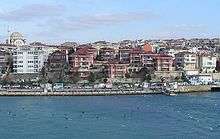
The district of Üsküdar is one of Istanbul's oldest-established residential areas. It is directly opposite the old city of Eminönü and transport across the Bosphorus is easy by boat or bridge. So there are well-established communities here, many retired people, and many residents commute to the European side for work or school (being cheap and central Üsküdar has a large student population). During the rush-hour, the waterfront is bustling with people running from ferryboats and motorboats onto buses and minibuses. Üsküdar also has the smell of the sea, the sound of foghorns, motorboats and seagulls and one of the best views of the city.
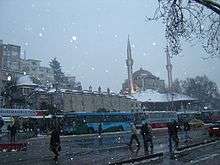
As of 2006, the central square is being dug up for a tunnel under the Bosphorus which will carry an underground railway. However, this is predictably continuously running into artifacts of great archaeological value.
The area behind the ferry dock is a busy shopping district, with many restaurants (including the well-known Kanaat Lokantası serving Ottoman cuisine, olive oil-based dishes, and ice cream) and a number of important Ottoman mosques (see section below). However, there are relatively few cafes, cinemas, billiard halls, and places for youth to congregate.
The private Üsküdar University, founded by Human Values and Mental Health Foundation, has a campus here.
Uskudar have two public libraries. Şemsi Pasha Mosque Public Library and Selimiye Public Library. Şemsi Pasha Mosque Public Library was built in 1953.
Neighborhoods
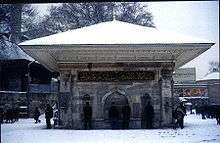
Üsküdar is a municipality within borders of Istanbul Metropolitan Municipality (büyükşehir). The municipality is subdivided into neighborhoods (mahalleler). The boundaries and names of the official neighborhoods change from time to time and sometimes do not correspond to historically recognized neighborhoods or to residents' own perceptions.
The most prominent neighborhood is Üsküdar's historic center (merkez), centered on the ferry docks and roughly corresponding to the current Mimar Sinan neighborhood (former Selmanağa, Tembel Hacı Mehmet, and İnkılap neighborhoods). This area includes large historic mosques, many businesses and markets, and is a transportation hub.
Other prominent neighborhoods include the former villages on the Bosphorus to the north of the historic center, Kuzguncuk, Beylerbeyi, Çengelköy, Kuleli, Vaniköy (now part of Kandilli), and Kandilli; the neighborhoods along the Bosphorus shore south of the historic center, Salacak, Harem (now part of Aziz Mahmud Hudayı), and Selimiye; and the mostly residential neighborhoods on the hilltops and hillsides, Doğancılar (now mostly part of Aziz Mahmud Hudayı), İmrahor (now part of Salacak), Selamsız (now part of Selamiali), Bağlarbaşı (now part of Altunizade), Altunizade, Acıbadem, Küçük Çamlıca, and Büyük Çamlıca (mostly in Kısıklı, Burhaniye, and Ferah).
Salacak
Üsküdar's long promenade along the coast from the center down in southern direction towards the bus station at Harem is popular in summer as it commands excellent views of the European shore of Topkapı Palace, Aya Sofya, Sultan Ahmed Mosque (The Blue Mosque), Taksim and Beşiktaş. This promenade is lined with cafes and restaurants, the most famous and prominent of which is not on the coast but out in the water: Kız Kulesi (Maiden's Tower), a small tower just off the coast that has existed since Byzantine times. From time to time it has been used as a toll booth; now it is used as an upscale restaurant and a venue for wedding parties. The name comes from a legend about a princess shut in the tower.
On nice days people gather on the shore to fish, sit and drink tea or to enjoy being out on the water in little rowing boats. There is a more recent mosque (1760) on the shore opposite the tower. The streets of Salacak behind the coast, in the area called Imrahor, are attractive and still hold a number of classic Ottoman wooden houses. The legendary 17th-century Hezarfen Ahmet Çelebi is said to have landed here on his hang-glider flight across the Bosphorus.
Further down along the coast is the Harem neighborhood, which contains a major intercity bus terminal and the Selimiye Barracks where Florence Nightingale once tended wounded British soldiers.[7] Behind the coast, towards the east, Üsküdar climbs steeply into the residential areas uphill, Bağlarbaşı and Doğancılar.
Doğancılar
A pleasant neighborhood on the hill above Salacak, with plenty of trees between the buildings and a small park. There is a wide avenue winding uphill from Üsküdar, which has plenty of shops and cafes, and also a theater (the Musahipzade Celal Sahnesi), the fire station, the former women's prison (Paşakapısı Prison), Burhan Felek High School and Doğancılar mosque (opposite the park).
Bağlarbaşı and Altunizade
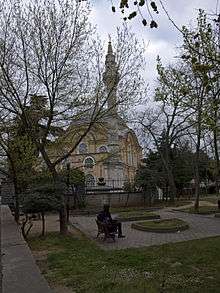
Formerly orchards and fruit-gardens (the meaning of bağ in Turkish). In the 19th century it became a residential neighborhood, home to the typical Istanbul urban mix of Greeks, Jews, Turks, and Armenians. The neighborhood still has an Armenian school and the Armenian church of Surp Garabed, built in 1844. Until the 1990s the area remained a middle-class residential neighborhood, and today is still an attractive district with a mixture of housing and office/commercial property. A number of properties have been converted to office and business use. Altunizade is still an attractive residential neighborhood, home to the large and busy Capitol shopping and entertainment center. Altunizade was established in the early 19th century by Altunizade İsmail Zühtü Pasha. He also constructed Altunizade mosque which was built in 1866.
There are a number of well-known schools within the district including Üsküdar American Academy, one of the oldest established schools in the city, Üsküdar High School, a state school, Haydarpasha High School, Marmara University's faculty of theology; and Burhan Felek sports complex.
Selamsız
Selamsız is an old residential neighborhood, home to a Roma (Gypsy) community and Roma culture.
Acıbadem
The top half of the attractive district of Acıbadem also belongs to Üsküdar, including Acıbadem and Academic hospitals. This avenue with its wonderful patisseries, ice-cream parlors and cafes, is the center one of the most pleasant neighborhoods of Istanbul, consisting of tree-lined streets and well-planned housing areas, as well as Çamlıca Girls High School set in a lovely tree-lined garden.
Up the Bosphorus
The boundary of the municipality of Üsküdar is far up the Bosphorus, and beyond lies Beykoz. The Bosphorus is among the more beautiful features of Istanbul. However, going up the Bosphorus from Üsküdar on the Anatolian side it is hard to find places to sit and enjoy the view; the coastal strip is either too narrow or is built on.
Üsküdar's up-north Bosphorus villages include:
Paşalimanı
Just past Üsküdar the coastline is called Paşalimanı. Liman means "port" in Turkish (from Greek limàni, λιμάνι) and boats would moor here. A large stone building on the shore, built as a tobacco warehouse by late-Ottoman architect Vedat Tek, has been completely renovated and now serves as headquarters of Ciner Grubu (Ciner Group), an industrial conglomerate. There is a small area of parkland right on the shore and the entrance to the large Fetih Paşa Korusu park is here.
Kuzguncuk
A Bosphorus village of streets with little shops, seaside cafes, and many old-fashioned wooden houses, Kuzguncuk has a village atmosphere. There is a ferry dock and a little park on the waterfront. The village was called Kosinitsa in the Byzantine period and until recently the people of Kuzguncuk were the typical Istanbul cosmopolitan mixture of Turks, Greeks, Jews, and Armenians. There are very few non-Muslims left today and the area has become an attractive middle-class neighborhood, home to people like film director Uğur Yücel, sculptor Kuzgun Acar, painter Acar Başkut (whose studio is in the village), architects Nevzat Sayin and Cengiz Bektaş, and the late poet Can Yücel. The neighborhood is also portrayed in the novel Mediterranean Waltz (Kumral Ada Mavi Tuna) by Buket Uzuner.
Beylerbeyi
Just beyond the Bosphorus bridge is Beylerbeyi, an area famous in Istanbul for its fish restaurants, and for the Ottoman palace on the shore. The Sabancı family of Turkish industrialists have sponsored the restoration and building of the school, police station and other public buildings, thus making them appropriate to the many very attractive houses and shops in the village.
Çengelköy
Formerly a quiet waterfront village, famous for the cucumbers grown in gardens on the green hillsides behind. There are a number of very grand seaside villas (yalı). The village has a number of shops, bakeries and waterfront cafes offering gorgeous views of the Bosphorus that tend to be busy, especially at weekends. Since the mid-1990s new housing estates have been built on the hillsides and now there are always queues of traffic through Çengelköy. But the village retains some of its romantic charm. The word çengel means "hook" or "anchor" in Turkish while köy means "village"; apparently there were blacksmiths or metalworkers in the village in Ottoman times.
The highly prestigious Kuleli Military High School is on the Bosphorus just beyond Çengelköy. Most graduates from here go on to military academy and careers as army officers.
Inland from the center of Üsküdar
Çamlıca
This hill, known as Tchamlidja in 19th-century spelling, has the highest point in Istanbul and commands a panoramic view of the entire city. One of the most prestiged schools of Turkey, Bilfen College is located on the Çamlıca hill.
Sights of Üsküdar
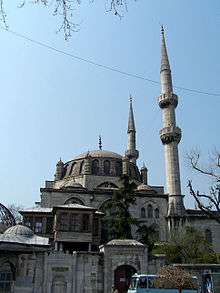
Though densely populated, Üsküdar has many areas of greenery, including the Çamlıca hills, the Bosphorus coastline, and various parks. In addition, the area has a high concentration of historic buildings and religious sites.
Parks
Fethi Paşa Korusu is a large park on the hillside coming right down to the Bosphorus shore slightly beyond Üsküdar in the area called Paşalimanı. It is named after Fetih Ahmet Paşa an Ottoman prince who among other things was responsible for industrializing the glassworks of Ottoman Turkey, and had a home in the area. The parkland is in fact privately owned and let to the state on condition that it is preserved as a park. The owners are the estate of pioneer Turkish industrialist Nuri Demirağ. There is a cafe in the park, a stone waterfall which children climb on and a small stage area where on Friday evenings in summer a band of amateur musicians give open-air concerts at sunset. At weekends the young lovers of Üsküdar collect here to stroll and cuddle in the shade.
Mosques
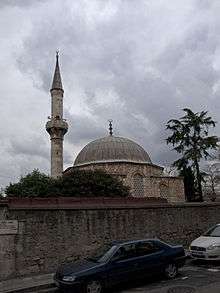
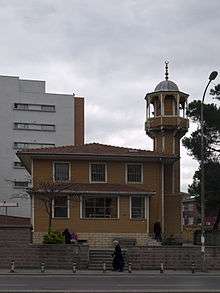
Üsküdar is home to over 180 mosques,[10] many of them historic Ottoman buildings, many built for women of the imperial harem, and many built by the famous architect Mimar Sinan. Among the first things one sees on arriving by ferry are the two mosques on either side of the ferry port, both designed by Sinan. The larger one is the Mihrimah Sultan Mosque, sometimes called the İskele (Dock) Mosque, built by a daughter of Suleiman the Magnificent; the smaller one is the Şemsi Pasha Mosque, built by a vizier of Suleiman's. Şemsi Pasha has a small library building in the courtyard where one can sit and enjoy the sea breeze off the Bosphorus.
A little further inland between the fountain of Ahmet III and the Şemsi Pasha Mosque is the large Yeni Valide Mosque, built by Ahmet III's mother. Uphill from the dock in the Valideiatik neighborhood is the Atik Valide Mosque, built by Murat III's mother and also designed by Sinan. Further uphill from there is the smaller Çinili (Tiled) Mosque. In Karacaahmet Cemetery is the large Şakirin Mosque, built in 2009.
The Namazgâh Mosque (built in 1860) in the eastern part of Üsküdar, close to the border with Ümraniye, is one of the few historical wooden mosques in Istanbul.
Other important mosques of Üsküdar include Ahmediye, Ahmet Ağa, Ahmet Çelebi, Altunizade, Ayazma, Aziz Mahmut Hudai, Baki Efendi, Beylerbeyi, Bodrumi Ömer Lütfi Efendi, Bostancı, Bulgurlu, Çakırcıbaşı, Fatih, Gülfem Hatun, Hacı Ömer, İmrahor, İranlılar, İstavroz, Kandilli, Kara Davut Pasha, Kaymak Mustafa Pasha, Kısıklı, Küleli Bahçe, Malatyalı İsmail Ağa, Mirzazade, Paşalimanı, Rum Mehmet Pasha, Selimiye, Solak Sinan, Tahır Efendi, Üryanizade, and Vanikoy.
Churches
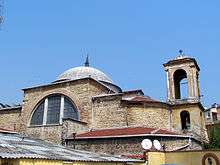
Churches of Üsküdar include the İlya Profiti (Prophet Elijah) Greek Orthodox Church in Muratreis (present building built in 1831), the Kandilli Khristos Rum Ortodoks Kilisesi (built in 1810), the Surp Garabet (Saint John the Baptist) Armenian Church in Murat Reis (first church on the site, 1590; present building built 1888), the Surp Haç (Holy Cross) Armenian Church in Selami Ali (built 1676, rebuilt 1880), the Surp Krikor Lusavoriç (Saint Gregory the Illuminator) Armenian Church in Kuzguncuk (first built 1835, rebuilt 1861), and the Surp Yergodasan Arakelots (Twelve Apostoles) Armenian Church in Kandilli (built 1846).[11][12]
Synagogues
Synagogues of Üsküdar include Bet Yaakov (built 1878) and Bet Nissim (built in the 1840s).[13]
Other religious buildings
Important tekkes (dervish lodges) include the Aziz Mahmud Hudayi Tekke (Aziz Mahmud Hudayi (1541–1628), who is buried in Üsküdar was the founder of the Jelveti Sufi order); the Nasuhi Efendi Tekke (Nasuhi Efendi was the founder of the Nasuhiyye Khalwati Sufi order and the grandfather of the Turkish American music producer Ahmet Ertegün, and the Özbekler Tekkesi where the Ertegün family members are buried.
Important tombs in Üsküdar include those of Aziz Mahmud Hudayi, Hacı Ahmet Pasha, Halil Pasha, İbrahim Edhem Pasha, Karaca Ahmet, and Rum Mehmet Pasha.
Çeşmes and sebils
Other notable Ottoman features to be seen in Üsküdar are the many çeşmes (drinking water sources) and sebils (kiosks for distribution of drinks). One of the largest and most visible çeşmes is the fountain of Ahmet III (1728–29), an impressive marble structure in the center of Üsküdar near the ferry docks.
Other important çeşmes of Üsküdar include Gülnuş Emetullah Valide Sultan (1709, next to the Yeni Valide Mosque), Hüseyin Avni Pasha (1874, Paşalimanı), Mustafa III (1760, next to the Ayazma Mosque), and Selim III (1802, in Çiçekçi, Harem İskelesi Street).[14]
Important sebils of Üsküdar include those of Hacı Hüseyin Pasha (1865, near the Karacaahmet Cemetery), Halil Pasha (1617, attached to Halil Pasha's tomb), Hudayi (first built in the 1590s but later much remodeled, near Aziz Mahmud Hudayi's tomb), Sadettin Efendi (1741, near the tomb of Karacaahmet Cemetery), Şeyhülislam Arif Hikmet Bey (1858, near the Kartal Baba Mosque), Valide Çinili (1640, next to the Çinili Mosque), Valide-i Cedid (1709, next to the Yeni Valide Mosque), and Ziya Bey (1866, near the tomb of Karacaahmet).[15]
Museums
The Florence Nightingale Museum inside the Selimiye Barracks in Selimiye displays items associated with Nightingale and her medical work in Istanbul during the Crimean War. The Beylerbeyi Palace Museum in Beylerbeyi shows the palace built for Abdülaziz in the 1860s.
Twin towns
Twin municipalities
Notable residents
- Maximus the Confessor - Byzantine monk, theologian and scholar. He entered a monastery in Chrysopolis in the early 7th century.[18]
- Philippicus - Byzantine general. He was a monk in a monastery in Chrysopolis between 602 and 610, and he was also buried in a church in Chrysopolis.[19]
- Sergius I of Constantinople - Ecumenical Patriarch of Constantinople.[20]
- Patriarch Pyrrhus of Constantinople - Ecumenical Patriarch of Constantinople.[21]
- Alexios Mosele - Byzantine aristocrat and general.[22]
- Michael III - Byzantine Emperor
- Florence Nightingale - English nurse, writer and statistician
- Mehmet Akif Ersoy - Turkish poet of the Turkish National Anthem
- Halide Edip Adıvar - Turkish novelist and feminist political leader
- Şeker Ahmed Pasha - Turkish painter
- Mehmed Orhan - Turkish aristocrat who was the 42nd head (pretender to the throne) of the Ottoman Dynasty
- Münir Ertegün - Turkish legal counsel in international law to the Ottoman Empire and diplomat of Republic of Turkey
- Ahmet Ertegün - Turkish-American musician and businessman, and founder and president of Atlantic Records and New York Cosmos soccer team
- Nesuhi Ertegün - Turkish-American record producer and executive of Atlantic Records and WEA International
- Barış Manço - Turkish rock singer, composer, and television producer
- Bülent Ersoy - transgender Turkish celebrity and popular singer of Ottoman classical music
- Özgü Namal - Turkish actress
- Zabel Sibil Asadour - Armenian poet and writer
- Calouste Gulbenkian - Armenian businessman and philanthropist
- Garabet Yazmaciyan - Armenian painter
- Onnik Chifte-Saraf - Armenian writer
- Gabriel Noradunkyan - Ottoman Armenian politician
- Yeghishe Tourian - Armenian Patriarch of Jerusalem and Constantinople
- Bedros Tourian - Armenian poet
- Hovhannes Hintliyan - Armenian pedagogue and educator
- Hrand Nazariantz - Armenian poet and writer
- Levon Shant - Armenian poet, writer, and playwright
- Sirvart Kalpakyan Karamanuk - Armenian composer, pianist, and teacher
- Schahan Berberian - Armenian philosopher, composer, and pedagogue
- Srpuhi Kalfayan - Armenian nun and philanthropist
- Zabel Yesayan - Armenian poet, writer, and teacher
References
Footnotes
- ↑ "Area of regions (including lakes), km²". Regional Statistics Database. Turkish Statistical Institute. 2002. Retrieved 2013-03-05.
- ↑ "Population of province/district centers and towns/villages by districts - 2012". Address Based Population Registration System (ABPRS) Database. Turkish Statistical Institute. Retrieved 2013-02-27.
- ↑ Mosque and Street, Scutari, Constantinople, Turkey. World Digital Library. 1890–1900. Retrieved 2013-10-18.
- 1 2 3 4 5 6 7 8 9 10 11 Taylor, Jane. Imperial Istanbul: A Traveler's Guide, page 219 . Palmgrave Macmillan, Oct 13, 1998 - 352 pages.
- 1 2 William Smith.Dictionary of Greek and Roman Geography — "Chryso'polis" 1854.
- ↑ François Sabbathier. Dictionnaire pour l'intelligence des auteurs classiques, grecs et latins: tants sacrés que profanes, contenant la géographie, l'histoire, la fable, et les antiquités. 1772. Volume 11, page 135. https://books.google.com/books?id=jOE1AAAAMAAJ&d
- 1 2 Cypresses and Road Leading to the Cemetery, Scutari, Constantinople, Turkey. World Digital Library. 1890–1900. Retrieved 2013-10-18.
- ↑ Soner Yalçın. Efendi.
- ↑ Vryonis, Speros. The mechanism of catastrophe: the Turkish pogrom of September 6–7, 1955, and the destruction of the Greek community of Istanbul. greekworks.com, 2005 - 659 pages, pages 168, 222
- ↑ Üsküdar Müftülüğü. Üsküdar Müftülüğüne Bağlı Camiler Listesi. http://www.uskudarmuftulugu.gov.tr/index.php?makaleid=77 Retrieved 10 August 2009
- ↑ Üsküdar Belediyesi. Kiliseler. http://www.uskudar.bel.tr/portal/rehber_/rehbern.jsp?PageName=rehbern&ID=10404&ADI=Kiliseler Retrieved 14 August 2009
- ↑ Tuğlacı, pages 121-129, 169-171, 194.
- ↑ Türkiye Hahambaşılığı (Chief Rabbinate).Synagogues: Asian Side of the Bosphorus. 2005. http://www.musevicemaati.com/index.php?contentId=27 Retrieved 14 August 2009
- ↑ T.C. Kültür ve Turizm Bakanlığı. İstanbul Çeşmelerinden Örnekler. 2005. http://www.kultur.gov.tr/TR/BelgeGoster.aspx?F6E10F8892433CFFA79D6F5E6C1B43FF856F72A66C829B67 Retrieved 10 August 2009
- ↑ Üsküdar Belediyesi. Tarihi Mekanlar. http://www.uskudar-bld.gov.tr/portal/rehber_/t1.jsp?PageName=main&RehberGrpId=8 Retrieved 10 August 2009
- ↑ Komuna e Sarajit binjakëzim me komunën turke Uskudar, INA, 2012-06-01 (in Albanian)
- ↑ http://www.dailysabah.com/istanbul/2015/08/12/brooklyn-uskudar-istanbul-and-new-yorks-iconic-districts-join-forces
- ↑ Kurian, George Thomas (2010). The Encyclopedia of Christian Literature. Scarecrow Press. p. 454. ISBN 0-8108-6987-X.
- ↑ Whitby, Michael (1988). The Emperor Maurice and his Historian – Theophylact Simocatta on Persian and Balkan Warfare. Oxford University Press. p. 129. ISBN 0-19-822945-3.
- ↑ Bischoff, Bernhard (1994). Biblical commentaries from the Canterbury school of Theodore and Hadrian. Cambridge University Press. p. 59. ISBN 0-521-33089-0.
- ↑ Bathrellos, Demetrios (2004). The Byzantine Christ: person, nature, and will in the Christology of Saint Maximus the Confessor. Oxford University Press. p. 65. ISBN 0-19-925864-3.
- ↑ Skylitzes, John (2010). A Synopsis of Byzantine History, 811-1057. Cambridge University Press. p. 66. ISBN 0-521-76705-9.
Sources
- Adım Adım İstanbul İnanç Atlası: Camiler, Türbeler, Ziyaret Yerleri, Mezarlıklar. Mapmedya. 2004. ISBN 975-6206-02-0.
- Hürel, Haldun (2008). Semtleri, Mahalleri, Caddeleri ve Sokakları A'dan Z'ye İstanbul'un Alfabetik Öyküsü. İkarus. ISBN 978-975-999-290-3.
- Kumbaracılar, İzzet (2008). İstanbul Sebilleri. Kapı. ISBN 978-9944-486-87-3. (First published 1938)
- Tuğlacı, Pars (1991). İstanbul Ermeni Kiliseleri = Armenian Churches of Istanbul = Istʻanpuli Hayotsʻ ekeghetsʻinerě. Pars. ISBN 975-7423-00-9.
| Wikimedia Commons has media related to Üsküdar. |

